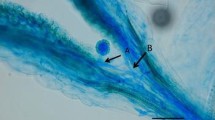Summary
An investigation into the conditions that lead to higher seed yields from species crosses of tulip has revealed that the temperature has an effect on seed production. Under constant temperatures, the best results in the phytotron were obtained at 14 °C.
Various problems associated with such crosses have been explained on the basis of microscopical observations. One of the factors associated with a poor seed yield from interspecific tulip crosses is the abnormal growth of the pollen tubes in the embryo-sac cavities of numerous ovules, with the result that fertilization does not take place.
The failure of the cross between Red Pitt, a Darwin tulip of the species T. gesneriana and the T. fosteriana tulips Mad. Lefeber and Princeps appears to be due to an inhibition of the pollen tube growth in the stigma.
Similar content being viewed by others
References
KhoY. O. & BaërJ., 1968. Observing pollen tubes by means of fluorescence. Euphytica 17: 298–302.
Oehler, E., 1958. Art-und Gattungskreuzung. In Kappert, H., and Rudorf. W., Handb. Pfl. Bd.l Aufl. 2: 563–611.
Author information
Authors and Affiliations
Rights and permissions
About this article
Cite this article
Kho, Y.O., Baër, J. Incompatibility problems in species crosses of tulips. Euphytica 20, 30–35 (1971). https://doi.org/10.1007/BF00146770
Received:
Issue Date:
DOI: https://doi.org/10.1007/BF00146770




